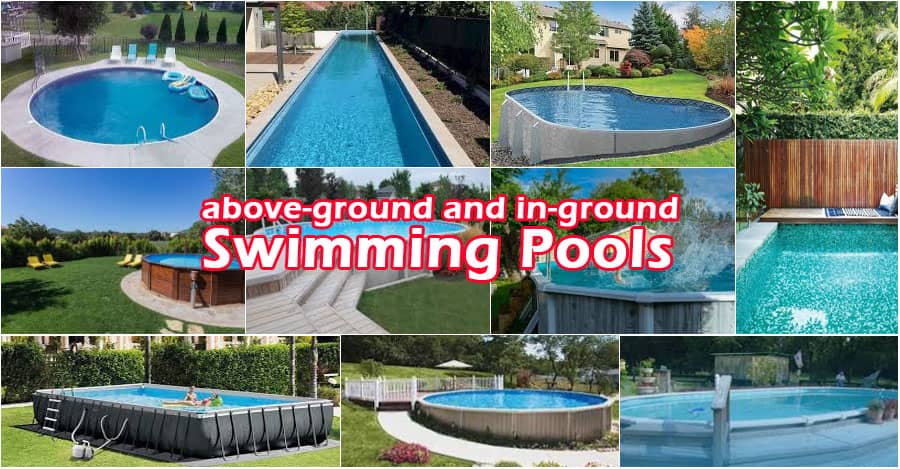Understand the concept of above-ground and in-ground swimming pools

Whether you choose an above-ground pool or an in-ground pool depends on your lifestyle and financial situation. An in-ground pool constructed in the backyard is almost standard in areas of the country where the weather is warm for the majority of the year. An above-ground pool could be the best option in colder climates or on a low budget.
In-Ground Pools
In-ground pools that are permanently placed can increase the value of your house, especially if you reside in an area where the weather is warm for the majority of the year. In addition to creating a beautiful landscape, a water feature that can be viewed inside the home, from a patio, or on a deck could also provide a beautiful view for residents.
There are disadvantages to having an in-ground pool, despite the fact that it offers a space for socializing, exercising, or relaxing. The initial cost is the most evident, as a pool requires a substantial investment. Then comes the yearly upkeep, which may result in an increase in your electric bill to run the heater and/or filter; an increase in your water bill to constantly refill as water evaporates; and additional costs for chemicals, cleaning, and opening and closing for the seasons if you live somewhere where the winters are too chilly to use the facility all year.
Shapes of In-Ground Pools
Concrete or gunite pools with custom-designed shapes can offer a wide range of shapes compared to inground pools. In-ground vinyl-lined pools are typically rectangular in shape, but they can also include rounded ends which are more commonly seen in rectangles. There are only a few shapes available in fiberglass pools, although there are still a lot of options available.
Above-Ground Pools
If you are on a tight budget or need a pool quickly, an above-ground pool may be the best option. Several days are needed to install them since they come in kits and are assembled by installers.
Decking and railing options are often added to more expensive above-ground pools when they are purchased or are already included in the price. By adding heaters to your pool, you can extend the swimming season. Above-ground pools are, by far, the least expensive type of pool. Known for their popularity among kids, they may be fenced in with an internal fence and have locking gates.
Shapes of Above-Ground Pools
In order to choose a swimming pool, you have to consider the shape of the pool as most above-ground pools are round or oval in shape, but the sizes of the shapes can vary as well. With this approach, you can choose a small pool and gradually work your way up to a larger pool as your family and your finances grow, thereby increasing the benefits of your swimming pool.
Aspects differentiating between In-Ground pools and Above-Ground Pools
There are a number of points of difference between the two, as follows:-
Designs of Pools
The shape, size, and additional features that you can choose from when it comes to an in-ground pool are greater than those for an above-ground pool. Depending on the design of the pool, it may be a long lap pool, a rectangular or round pool that can be used for relaxing or playing with friends, or a combination of these two types of pools.
Installation procedure
In-ground pool installation is a difficult task that should only be handled by experts. Excavation is necessary for in-ground pools, which might be difficult if the workers encounter bedrock, groundwater, or other obstacles.
On the other hand, above-ground pools are far easier and less time-consuming to install; you only need a level piece of ground. Onground pools don't require excavation, which saves time, planning, and other construction work.
The durability of both the pools
Depending on the type, a pool might be very durable or very fragile. Since there are no exposed walls, inground built-in pools are less likely to be harmed by the weather or by accidents. However, if this does happen, repairs are more expensive?in some situations, more expensive than the overall cost of an above-ground pool.
It is easier to remove and replace an above-ground pool. As an above-ground pool has exposed sides, it is less robust and more likely to be damaged by accidents or storms.
When it comes to maintenance
Any pool type requires the same duties to maintain water quality: cleaning, filtration, and keeping chemical balance. For in-ground pools' greater maintenance needs compared to above-ground pools, you might need to employ a pool contractor. In contrast, maintaining above-ground pools is significantly simpler and less expensive.
Safety issues
The above-ground pool is often the safest of the two pool styles. Because the above-ground pool includes walls and a removable ladder, accidental drownings are less likely.
Alternatively, an in-ground pool can be constructed with a family-friendly swimming area. Hardcovers should be used in all pools during the winter, as well as four-sided safety fences with self-closing locks.
End Thoughts
In-ground and above-ground pools both have advantages and disadvantages. In-ground pools may be the focal point of a spectacular backyard, with features and designs only constrained by your creativity if you are ready to spend the money.
Although less expensive than in-ground pools, above-ground pools lack style. They are a great compromise for any homeowner who wants the enjoyment of a pool without the upkeep of an in-ground pool since they may be embellished.
